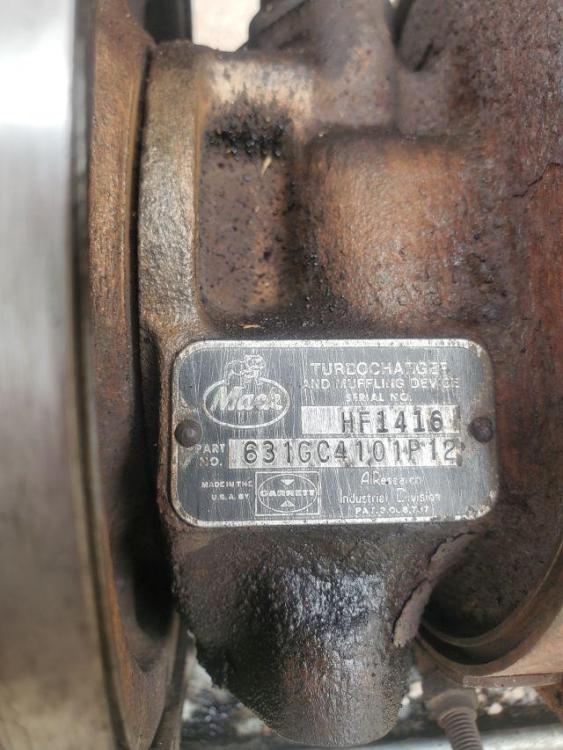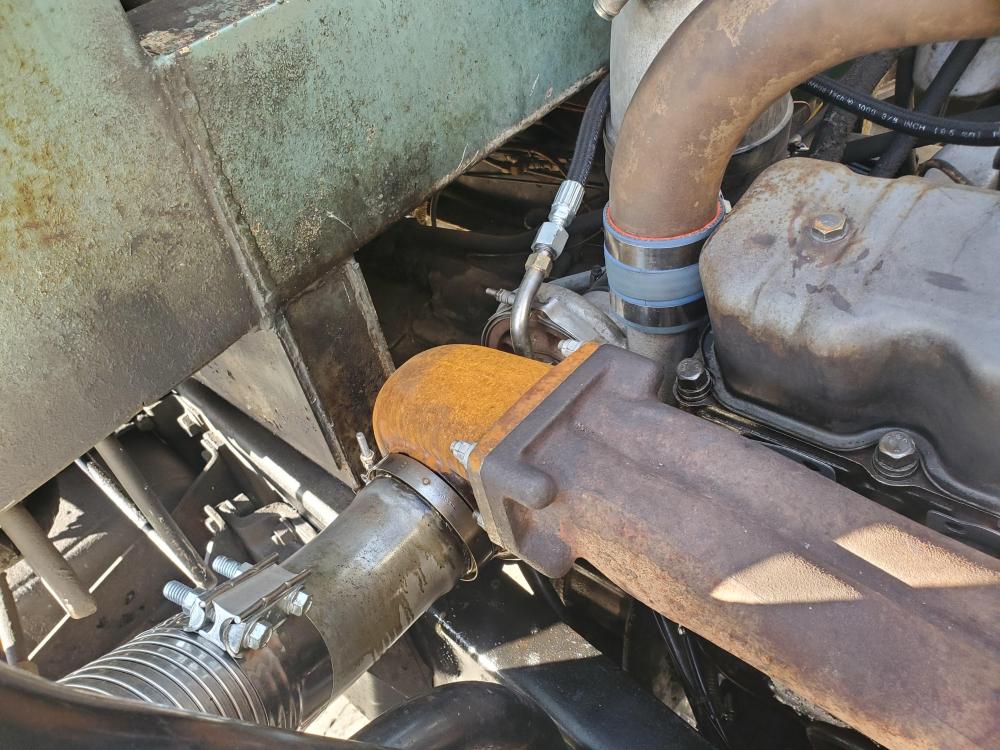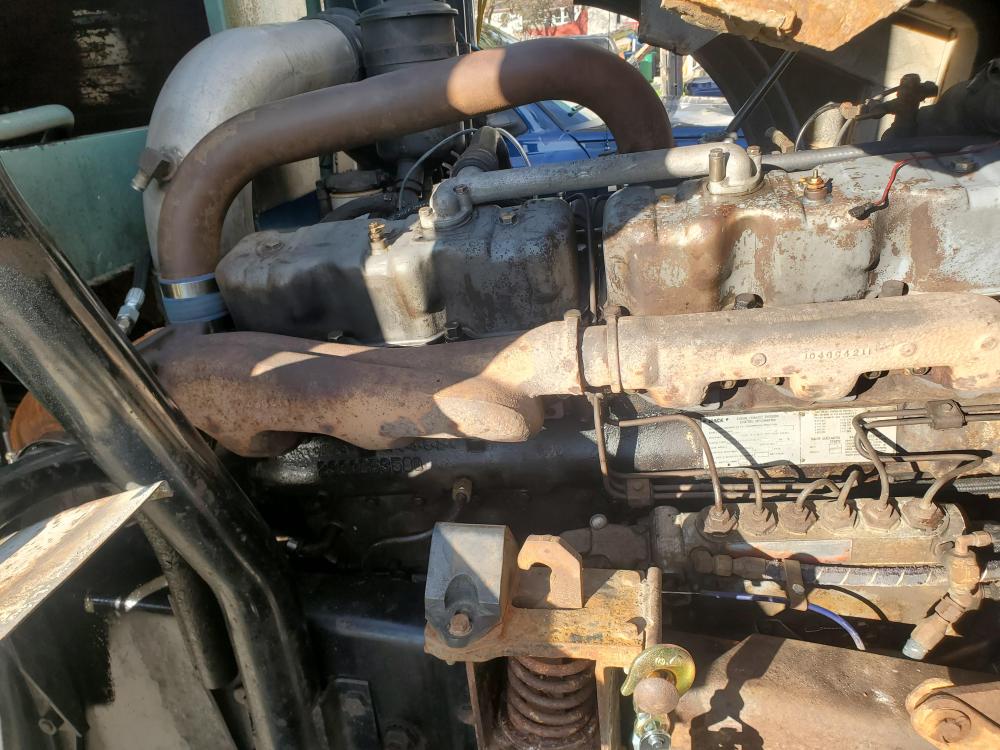
RS Disposal
Bulldog-
Posts
159 -
Joined
-
Last visited
Content Type
Profiles
Forums
Gallery
Events
Blogs
BMT Wiki
Collections
Store
Everything posted by RS Disposal
-
1979 Mack E6 engine cooling issue
RS Disposal replied to RS Disposal's topic in Engine and Transmission
I believe the model is MR685. Dealer lists it as a box truck, but it has a garbage compacter body on it -
1979 Mack E6 engine cooling issue
RS Disposal replied to RS Disposal's topic in Engine and Transmission
I will definitely look at that when I change out the water pump. Pretty sure the radiator needs rodding out. I'm just trying to understand this engine as I'm sure you are aware of from my "Needing Mack Head" thread -
1979 Mack E6 engine cooling issue
RS Disposal replied to RS Disposal's topic in Engine and Transmission
I do have the heat activated clutch fan. I can hear it roar to life at times but not really when I would think it should be. I have a cab over so I'm right there by the fan. That was one thing on my list of replacing as I troubleshoot the problem. Pretty sure my radiator needs to be rodded, but right now my truck can't be down for that length of time so I just watch my temp really close. Its fine all day long in the valley -
1979 Mack E6 engine cooling issue
RS Disposal replied to RS Disposal's topic in Engine and Transmission
My truck doesn't have a CAC and have washed off the radiator fins. Was the first thing I thought of. Pretty sure I am going to have to eventually take radiator into the shop. But was just wondering about how much of the coolant actually flowed thu the water filter. I do understand the problems a bad thermostat can cause. Right now just trrying the simple things first one at a time. I'm one that likes to know what fix works and what doesn't work. -
From what I understand these brass radiators do need to be rodded out occasionally, Which is something I am planning on. But I thought I would tackle the simple things first. In going thru the maintenance history, I don't see where the water filter was last changed. My question is does all the water flow thru the filter or only a portion of it as the systems circulates the coolant? Could a plugged filter be a problem? Going to change that today anyway just so I can log when it was changed. Also bought a thermostat kit That I will hopefully change out later this week, weather cooperating being I work outdoors, just in case I do have a problematic thermostat. The truck runs about 190 all day long in the city. Only gets hot when I climb the canyon, where I do stop and let it cool.
-
Rebuilt turbo and noise in the intake
RS Disposal replied to RS Disposal's topic in Engine and Transmission
compressor intake is before turbo -
Rebuilt turbo and noise in the intake
RS Disposal replied to RS Disposal's topic in Engine and Transmission
I have thought of that but haven't done it. I wouldn't think that would cause the boost gauge to flutter -
Rebuilt turbo and noise in the intake
RS Disposal replied to RS Disposal's topic in Engine and Transmission
If I had a loose valve seat wouldn't I get a mechanical sound rather that what sounds like a muffled pop pop? The sound only changes frequency with engine rpm, doesn't really get any louder or softer whether under load or coasting. Truck doesn't appear to have an engine miss and it pulls smooth. Going to, as I stated in my first post, get a clip of the noise and post. Going to do some trouble shooting, check exhaust temps with an infrared heat gun and also use a stethoscope and see what I can hear and find. Will pull rocker covers and double check valve lash and see if something there has changed. Just frustrated I can't seem to locate. -
I just recently had to do a major repair on my engine, a 1979 Mack ENDTB 675 which required replacing the turbo (previous topic was "Looking for 1979 Mack head"). Wasn't able to find a direct replacement but this rebuilder stated this one was speced out to be a replacement. The rebuilt turbo has a larger diameter compressor housing (cold side). I have noise in the intake. The truck seems to be running ok, doesn't appear to be missing, idles smooth. This truck never had a boost gauge before for a reference comparison, but the boost gauge will flutter depending how far I'm into the throttle. A quick question, pretty sure this turbo is producing more boost than the original. From what I have been able to find out, the original was around 15 - 17 lbs boost. This turbo looks like it will boost upwards of around 20 lbs boost. I don't let it run that high before I back out of it. Is there a possibility that this much boost for THIS engine might be cause some mechanical issues? I know my Cummins N14 runs around 20 lbs when going up the canyon where my trucks work, but that that is a totally different and much larger engine. I will try and upload a video/audio file in the morning with the noise. If this is the new normal after this engine repair, I'm good with that, because it was a major repair. Rear head rebuilt and #4 piston replaced. I just don't like noises that I don't remember from before the breakdown.
-
Looking for 1979 Mack engine head
RS Disposal replied to RS Disposal's topic in Engine and Transmission
I am still having this noise in the intake. The truck seems to be running ok. A quick question, pretty sure this turbo is producing more boost than the original. From what I have been able to find out, the original was around 15 - 17 lbs boost. This turbo looks like it will boost upwards of around 20 lbs boost. I don't let it run that high before I back out of it. Is there a possibility that this much boost for THIS engine might be cause some mechanical issues? I know my Cummins N14 runs around 20 lbs when going up the canyon, that that is a totally different and much larger engine. I also think I might start a new topic with this issue where as I am no longer looking for a head. -
Looking for 1979 Mack engine head
RS Disposal replied to RS Disposal's topic in Engine and Transmission
I definitely marked the TDC marks and now that I know they are there, when I need them again I will know -
Looking for 1979 Mack engine head
RS Disposal replied to RS Disposal's topic in Engine and Transmission
Yea, I do understand the concept of the timing of only one cylinder at a time. Before I realized there were marks on the vibration dampener I was bumping the engine over, but it was hard to know for sure if I was on true TDC because alot of the time the engine would spin backwards a bit due to compression. There is only only one pointer on the front of my engine. The marks were extremely hard to see, but I was able to actually locate them after cleaning off the vibration dampener. I was able to get to the approximate location of the marks by counting the number of teeth on the flywheel for a full revolution from the #1 TDC mark and dividing by 3 to give me an idea of where to look. I was then able to get right on by slowly rotating the engine a tooth at a time untill the TDC marks were right on -
Looking for 1979 Mack engine head
RS Disposal replied to RS Disposal's topic in Engine and Transmission
I think when it comes time to do the radiator I will take it into a local shop that does heavy truck radiators. I don't have the expertise or tools to do the soldering of this brass radiator -
Looking for 1979 Mack engine head
RS Disposal replied to RS Disposal's topic in Engine and Transmission
another quick question. The truck was running good up until this point. I was double checking my valve lash and did find some that were out of spec. I may of not actually had the Piston at true TDC. After some clean u9p I was able to find the marks on the vibration dampener at the 120 degree spacing. Readjusted everything using these marks and the truck seems to be back to normal. Question is, "why the hiccup"? -
Looking for 1979 Mack engine head
RS Disposal replied to RS Disposal's topic in Engine and Transmission
cam was never removed. just the rear head. And the stinking truck was running so good too. Was gonna kinda pat myself on the back for a job well done. Guess I spoke too soon -
Looking for 1979 Mack engine head
RS Disposal replied to RS Disposal's topic in Engine and Transmission
started the engine with the tube from the turbo removed. Sounded like a popping noise coming out of the intake manifold. was thinking thaty for some reason maybe an intake valve wasn't closing all the way. Took rocker cover off and double check my valve lash. Some of the exhaust were a little loose.. Now when I start it it smokes (white smoke) really bad and idle rough. What the crap did I do? If I tightened the exhaust too tight would that cause the smoking? So dang hard to gauge TDC and rotating engine 1/4 turn. -
Looking for 1979 Mack engine head
RS Disposal replied to RS Disposal's topic in Engine and Transmission
Well I forgot my heat gun this morning so that will have to wait But I had another issue arise just after I came down the canyon with a load on. I am getting what I can best describe is a pulsating noise coming from the air filter intake. The boost gauge flutters. As to how much depends on throttle position. Haven't had the chance to tilt cab yet and look around. What might I be looking for? Could a rubber hose come loose or cracked? There are several between the turbo and intake manifold. The engine seems to still be running smooth. Seems I just can't catch a break and have just entered into my busy season -
Looking for 1979 Mack engine head
RS Disposal replied to RS Disposal's topic in Engine and Transmission
Running a 15 lb radiator cap RPM's are around 1800. I can run around town all day long and engine runs around 180-190 according to the temp gauge -
Looking for 1979 Mack engine head
RS Disposal replied to RS Disposal's topic in Engine and Transmission
I will use my heat gun tonite when I go back up canyon and check radiator temp. I stop to let cool once my temp gauge hits about 220. -
Looking for 1979 Mack engine head
RS Disposal replied to RS Disposal's topic in Engine and Transmission
truck is back to work and appears to be running ok. Only issue, which started last summer before it died, is it gets hot climbing the canyon where most of my pickups are. Canyon is between 6 - 9% grade and 8 miles long. I just watch engine temp and stop and let it cool, which it does within 5-10 minutes at idle, and continue on. In the valley it runs between 180 & 190 all day long. Pretty sure radiator needs to be rodded out. Nothing has ever been done to it since new and truck is 1979. Will have to just watch engine temp until my slow season before I can take it out of service for several days or so again. I think at the same time just for shits and giggles replace water pump, fan clutch and thermostat. Here is another newby question as far as turbocharged big diesel engines. As far as the turbo boost is concerned, what exactly determines the amount of boost you get? Is it the diameter of the compressor housing? New turbo compressor housing is larger in diameter, but also not as wide as original. This truck has never had a boost gauge, so I have no comparison to go by. Around town I am running between 6-10 lbs boost. When climbing canyon I can get as high as 18-20 lbs boost. Climbing canyon pyrometer shows 600 - 700 degrees and around town 400 - 500 degrees. Sticker on the original gauge says max temp is 1125 and it doesn't get anywhere near that and the sensor is in the same place as original. Again I want to thank everyone for their help and insight that was given on my learning experience over the last several months. Here's wish each and everyone of you a joyous new year and wishes for a great year to come. -
Looking for 1979 Mack engine head
RS Disposal replied to RS Disposal's topic in Engine and Transmission
Well, after 4 disappointments on getting a rebuilt turbo I was finally able to get one and get it installed. According to the rebuilder it specs out to be the same as my original, but the compressor housing is larger in diameter, although narrower in width, which presented a couple of minor problems in installing. I had to undo a frame strut and also install a 1/4 inch spacer because the housing would hit a bolt on the rear of the engine. Other than that, everything seemed to line up ok. When I have the engine running at idle I am picking up noises that I don't remember hearing before. Not bad noises I'm pretty sure. Most likely I am thinking I am just being much more intense in my listening than before because of the major breakdown I just had to repair. It has been a tough and interesting journey for the 3 1/2 months my truck was down. Tomorrow she goes back into service with my fingers crossed. On another note, I decided to install a boost gauge, which it never had before, and was wondering what kind of boost pressures I would be looking at and whether or not the slight differences in the turbo compressor housing would have any great effect on that. I also decided to reinstall a pyrometer, which it did have years ago but when some exhaust work was done at one time the sender was never reinstalled and being the original is no longer available, I put in an aftermarket. A sticker in the cab by the original gauge states 1125 degrees (I think) max. Is this about what I would be looking at. My other truck does have both of those gauges, but it is a much larger motor (Cummins N14) and off hand I don't remember what it would run on those gauges anyway. Also, if anyone out there might need, I do have a new in box Mack 185606 CHRA and a never installed rebuilt 4LE-292 turbo, both of which I purchased in my trek of trying to get something that would work. I will post here how the truck does on her first day back to work. I want to THANK everyone here for all your help and guidance, this forum has been invaluable in my learning experience. -
Looking for 1979 Mack engine head
RS Disposal replied to RS Disposal's topic in Engine and Transmission
-
Looking for 1979 Mack engine head
RS Disposal replied to RS Disposal's topic in Engine and Transmission
-
Looking for 1979 Mack engine head
RS Disposal replied to RS Disposal's topic in Engine and Transmission
-
Looking for 1979 Mack engine head
RS Disposal replied to RS Disposal's topic in Engine and Transmission
I wou8ld really appreciate that
BigMackTrucks.com
BigMackTrucks.com is a support forum for antique, classic and modern Mack Trucks! The forum is owned and maintained by Watt's Truck Center, Inc. an independent, full service Mack dealer. The forums are not affiliated with Mack Trucks, Inc.
Our Vendors and Advertisers
Thank you for your support!






